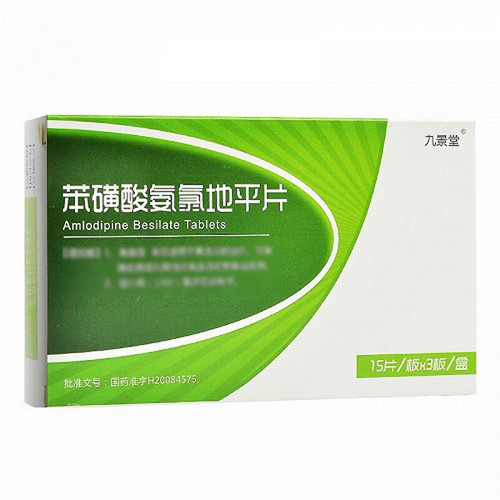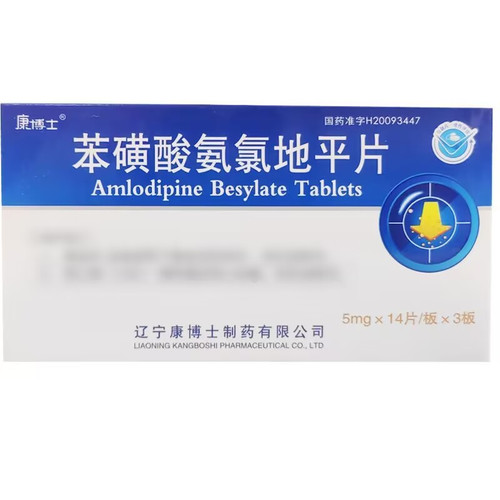Product Overview
[Drug Name]
Generic Name: Amlodipine Besylate Tablets
Trade Name: Lingkang Amlodipine Besylate Tablets 5mg*56 Tablets
Pinyin Code: LingKang BenHuangSuanAnLvDiPingPian 5mg*56 Tablets
[Main Ingredient]
Amlodipine Besylate
[Properties]
This product is a white tablet.
[Indications/Main Functions]
1. Hypertension: This product is indicated for the treatment of hypertension and can be used alone or in combination with other antihypertensive drugs. 2. Coronary Artery Disease (CAD): Chronic Stable Angina: This product is indicated for the symptomatic treatment of chronic stable angina. It can be used alone or in combination with other antianginal drugs. Vasospastic Angina (Prinzmetal's or Variant Angina): This product is indicated for the treatment of confirmed or suspected vasospastic angina. It can be used alone or in combination with other antianginal drugs.
[Specifications]
5mg*56 tablets
[Dosage and Administration]
The typical starting dose for hypertension in adults is 5 mg once daily, with a maximum dose of 10 mg once daily. For patients who are small, frail, elderly, or have hepatic insufficiency, the starting dose is 2.5 mg once daily; this dose may also be used in combination with other antihypertensive medications. Dose adjustments should be made based on individual patient response. Dosage adjustments should generally be initiated after 7-14 days. If clinically necessary, dose adjustments can be made more quickly under close patient monitoring. The recommended dose for the treatment of chronic stable or vasospastic angina is 5-10 mg once daily. Lower doses are recommended for elderly patients and those with hepatic insufficiency; the effective dose for most patients is 10 mg. The recommended dose for the treatment of coronary artery disease is 5-10 mg once daily. In clinical studies, most patients required a dose of 10 mg/day.
[Adverse Reactions]
This product is well tolerated within the 10 mg/day dose range, with most adverse reactions being mild to moderate. Discontinuation due to adverse reactions was only 1.5%, not significantly different from placebo (approximately 1%). The most common adverse reactions were headache and edema. Dose-related adverse reactions with an incidence of 1% were edema, dizziness, hot flashes, and palpitations. Adverse reactions with an unclear dose relationship but an incidence exceeding 1.0% were headache, fatigue, nausea, abdominal pain, and somnolence. Among these adverse reactions, edema, hot flashes, palpitations, and somnolence were more common in women than in men.
[Contraindications]
This product is contraindicated in patients with hypersensitivity to dihydropyridines or any of the ingredients in this product.
[Precautions]
1. Angina and/or Myocardial Infarction: Rare. Patients with severe obstructive coronary artery disease may experience an increase in the frequency, duration, and/or severity of angina attacks, or the development of acute myocardial infarction, when initiating or increasing the dose of calcium channel antagonists. The mechanism is unknown. 2. Hypotension: Since this product gradually produces a vasodilatory effect, acute hypotension rarely occurs after oral administration. However, caution should still be exercised when this product is used in combination with other peripheral vasodilators, especially in patients with severe aortic valve stenosis. 3. Patients with heart failure: Calcium channel blockers should be used with caution in patients with heart failure. 4. Patients with hepatic insufficiency: This product should be used with caution in patients with severe hepatic insufficiency. 5. Patients with renal failure: The starting dose for patients with renal failure can remain unchanged. 6. Discontinuation of beta-blockers: This product has no protective effect against rebound symptoms caused by sudden discontinuation of beta-blockers. Therefore, discontinuation of beta-blockers still requires a gradual reduction in dose. 7. This product can be used safely in patients with obstructive pulmonary disease, well-compensated heart failure, peripheral vascular disease, diabetes, and lipid disorders.








